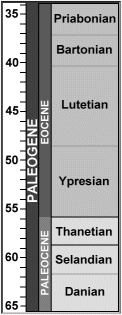| |
Cappetta (1992) erected this genus for Scyliorhinidae teeth with rather large cusps (to 6 mm in height). The lingual face is convex & smooth and the labial (which barely overhangings the root) less convex with enameloid ridges (vertical folds) at its base; one or two pairs of lateral cusplets may be present. Teeth of this design are characterized by the expanded root (labial & lingual) and an unusually erect crown relative to the basal face of the root.

Species attributed to this genus include:
P. degremonti CAPPETTA 1992 late Ypresian of France
P. peypouqueti NOUBHANI & CAPPETTA (1997) Thanetian, Morroco
P. subulidens ARAMBOURG (1952) Danian through Lower Ypresian, Morroco
P. uralica MALYSHKINA (2006) Priabonian, Tavda Formation, Kurgan, Russia.
Teeth from this genus also appear in North American sediments, having been found by the author in the Aquia Formation [Selandian] of Maryland (Fig. ) and the Nanjemoy [Ypresian] of Virginia. Kent 1999 reported P. degremonti from Potapaco bed B of the Nanjemoy. The P. degremonti tooth-design (Fig. & ) is the most common in this fauna, however a second much less common design (Fig. ) is also present with cusplets more reminiscent of P. subulidens.
These teeth are usually found by bulk screening and can be readily overlooked because of their similarity to those of the ever abundant Abdounia. Under magnification however, the similarities disappear. The defining differences include:
Short enameloid folds on the labial face (usually present)
Vertical orientation of the cusp relative to the basal face of the root
Lingually oriented foramen in the nutrient groove
A flaring of the root basally (both labially and lingually)
Based on Nanjemoy material, the dentition would have been of a clutching/grasping design with monognathic heterodonty. The cusps of antero-laterals are erect and the medio and postero-laterals distally inclined (more so in the uppers). Uppers can be distinguished from lowers based on lateral profile, the uppers are relatively erect and the lowers lingually directed.
Selected References
Arambourg, C. 1952. Les vertébrés fossiles des gisements de phosphates (Maroc-Algerie-Tunesie). Notes et Mémoires. Service des Mines et de la Carte Géologique du Maroc 92: 1-372. Paris.
Cappetta, H. 1992. Carcharhiniformes nouveaux (Chondrichthyes, Neoselachii) de l’Yprésian du bassin de Paris. Geobios 25 (5): 639-646.
Kent, B.. 1999. Sharks from the Fisher/Sullivan Site. In: R.E. Weems (ed.), Early Eocene Vertebrates and Plants from the Fisher/Sullivan Site (Nanjemoy Formation) Stafford County, Virginia. Virginia Division of Mineral Resources 152: 11-52.
Malyshkina, T. 2006. Late Eocene scyliorhinid sharks from the Trans-Urals, Russia. Acta Palaeontologica Polonica 51(3): 465-475.
Noubhani, A. and Cappetta, H. 1997. Les Orectolobiformes, Carchariniformes et Myliobatiformes (Elasmobranchii, Neoselachii) des Bassins a phosphate du Maroc (Maastrichtien-Luteten basal): systematique, biostratigraphie, evolution et dynamique des faunes. Palaeo-Ichthyologica 8: 1-327. Pfeil, Munchen.
|